Merritt Johns, M.S., Manager of Marketing Communications,
Victor Bray, Ph.D., Vice-President for Auditory Research, and
Michael Nilsson, Ph.D., Principal Researcher.
SONIC innovations
2795 East Cottonwood Parkway, Suite 660
Salt Lake City, Utah 84121-7036
Introduction:
The primary complaint of most hearing impaired adults with mild to moderate hearing loss is they can't understand speech in background noise. Therefore, improving the signal-to-noise ratio is a common goal of most advanced hearing instrument designs. This is accomplished by enhancing the signal with respect to the background noise. However, the actual process of improving the signal-to-noise ratio varies from manufacturer to manufacturer. Noise reduction strategies range from audio expansion, to directionality, and to multichannel spectral subtraction.
The 'SE' series of hearing aids from SONIC innovations (NATURA™ 2 SE and CONFORMA™ 2 SE) use both audio expansion and multichannel spectral subtraction. Based on SONIC innovations' unique and proprietary implementation, audio expansion will be referred to as Speech Weighted Expansion™ and multichannel spectral subtraction will be referred to as Personalized Noise Reduction™. Both are effective noise reduction tools. However, they differ in features and benefits.
Passive Noise Reduction:
Speech Weighted Expansion (SWE) is a 'passive' form of noise reduction.1,2,3 Expansion does not actively seek out noise for differential signal processing. SWE simply provides less gain for softer inputs, or inputs lower in intensity than the long-term average speech spectrum. These low-level inputs are typically internal (microphone noise) and/or external (ambient noise) to the hearing aid. Through the use of SWE, soft background sounds and/or internal noises receive amplification, but they receive less amplification than inputs likely to be speech. Therefore SWE is a passive noise reduction tool that gives less gain to low-level noise and more gain to speech.
Active Noise Reduction:
Personalized Noise Reduction (PNR) is 'active' noise reduction.4,5,6 Since this form of noise reduction needs to 'actively' seek and subtract the spectrum of the noise, the system needs a method to determine the difference between speech and noise. Thus, the noise reduction system needs to be able to detect 'target (speech) versus masker (noise)' in a single input. In the PNR design, the target is the modulated component and the masker is the steady-state component of the input. The noise reduction algorithm provides more amplification for the modulated (speech-like) target and less amplification for the steady-state (probable noise) masker. PNR goes beyond passive noise reduction as it not only actively seeks, but also actively reduces background noise (i.e. steady-state sounds) ranging from low-level to high-level originating from any direction external to the hearing instrument.
As its name suggests, PNR is personalized for each hearing impaired individual. The individual's audiometric thresholds (mild, moderate, severe) determine the initial noise reduction setting in the EXPRESSfit™ fitting system (low, medium, or high). Additionally, the noise reduction system interacts with the hearing instrument's AGC settings - which result from the individual's audiogram, personal dynamic range, and personal gain preferences. Lastly, the noise reduction system takes into account the individual's changing acoustic environment and monitors the signal-to-noise ratio in each of nine frequency channels adjusting the frequency-specific amplification levels accordingly in each channel and in each hearing aid.
Although PNR does have similarities to other active noise reduction systems (in terms of its use of time analysis, spectral subtraction, and its operation across multiple frequency channels), it possesses unique attributes that distinguish the product. Unique to SONIC innovations' PNR design are its' spectral, temporal, and amplitude characteristics.
Spectral Characteristics:
Personalized Noise Reduction is integrated with SONIC innovations' digital signal processing employing 9-channel, very fast-acting compression. The signal processing design, modeled after the human auditory system, centers on providing audibility while preserving the perception of loudness. In order to manipulate loudness, the system focuses on changes in amplitude carried in the envelope of the signal.
All auditory signals are composed of an envelope and vibration. An easy way to conceptualize the vibration and envelope components of sound is by examining the speech sample 'Soon Vikings ruled the North' as demonstrated in Fig. 1. The signal is separated into two components; the vibration is the blue component that quickly varies in frequency/rate (Figure 2a) and the envelope is the red component, which is slowly varying with a low frequency/rate (Figure 2b). After the DSP (digital signal processor) system separates the envelope from the vibration, the envelope is processed through the 9-channel compressors to adjust frequency-specific gain levels appropriately.
Figures 1 (top), 2a (middle) and 2b (bottom): Time waveform of 'Soon Vikings ruled the North' showing the vibration component of speech in blue (1 and 2a) and the speech envelope as the dotted red line (1 and 2b).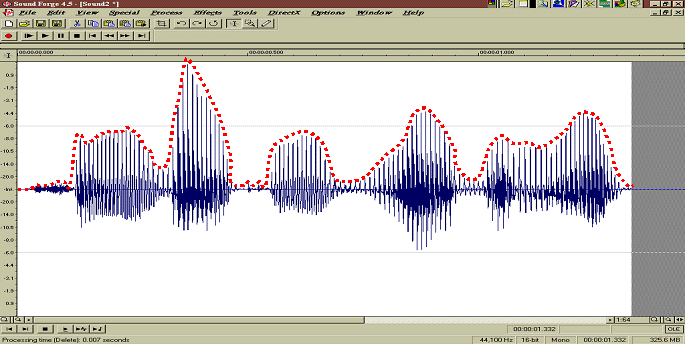
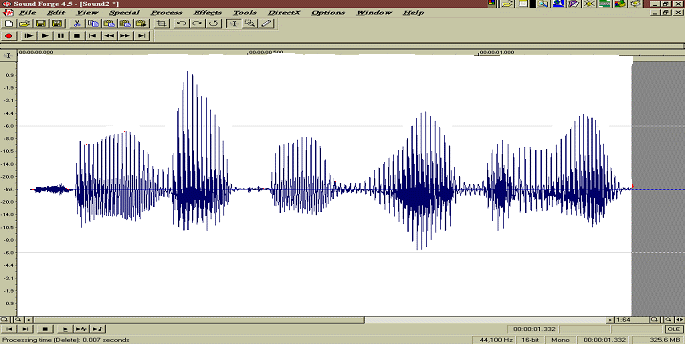
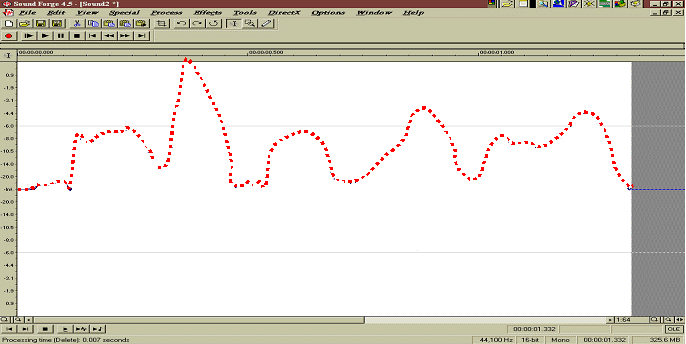
Similar to the core signal processing, the noise reduction algorithm also monitors and responds to amplitude changes in the envelope. The integration of SONIC innovations signal processing with PNR allows the listener to change from a quiet to a noisy environment without noticeable artifacts in the amplification of the speaker/target.
Temporal Characteristics:
SONIC innovations' core signal processing and the Personalized Noise Reduction system utilize unique time constants; they are very fast, frequency dependent, and symmetric with respect to attack and release times. Before the PNR system adjusts for the noise in each of the nine frequency channels, it must first detect the noise. The system requires 2-3 seconds to recognize the steady state noise in each of the nine narrow band frequency channels ('A' in Figure 3) and engage ('B' in Figure 3). After the PNR engages, the monitoring process begins where the system determines the level of the noise, the portion of the entire signal that is noise, and the approximate signal-to-noise ratio ('C' in Figure 3). Similar to the engaging process, the monitoring process occurs in each of the nine frequency channels. This process occurs in real time and applies very fast acting symmetric attack and release times.
Figure. 3. The words' bathe, it, wet, give' at +5 dB S/N in white noise with (green) and without (blue) noise reduction signal processing. 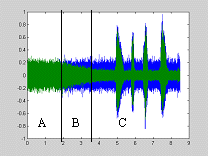
The use of real time analysis and fast-acting AGC time constants allows for very quick loudness adjustments that are not audible to the patient and thus 'pumping' sounds (which are sometimes associated with compression) are not detected when PNR is active. This more closely approximates the temporal characteristics of the human auditory system and provides a more natural hearing experience, with or without the noise reduction algorithm activated.
Amplitude Characteristics:
In contrast to other noise reduction systems, PNR is noise amplitude independent. It does not simply examine the noise levels in each of the frequency channels and make an adjustment or shut down a channel containing noise. Instead, PNR's sensitivity is to the signal-to-noise ratio in each of the nine frequency channels. The signal-to-noise ratio results from dividing the level of the target signal (in dB SPL) by the level of the masker/noise (in dB SPL). Thus, the system not only examines the level of the noise, but also compares it to the level of the speech.
The amount of noise reduction is dependent on the approximate signal-to-noise ratio for each channel and the noise reduction setting. Noise reduction is greatest with a low signal-to-noise ratio, i.e. +5 S/N (signal is 5 dB greater/louder than the noise). Less noise reduction is applied as the signal-to-noise ratio becomes more positive or improves, i.e. +10 S/N. Thus as the signal continues to increase, in contrast to the noise (i.e. 15 dB greater than the noise), the system applies less noise reduction.
The amplitude of the PNR algorithm is also frequency independent, whereby it will reduce gain equally in all frequencies where noise is present. Figure 4 shows the effects of the three programmable EXPRESSfit™ PNR settings on a steady-state noise signal. The noise in this example is Fonix 'speech weighted composite noise' and the measurements are with the aid attached to a 2cc coupler. The low, medium, and high PNR settings result in 6, 12, and 18 dB of noise reduction, respectively.
Figure 4. 2 cc coupler measures showing frequency responses without noise reduction (top, black line), with low noise reduction (6 dB down from top line), medium noise reduction (12 dB down) and high noise reduction (18 dB down). 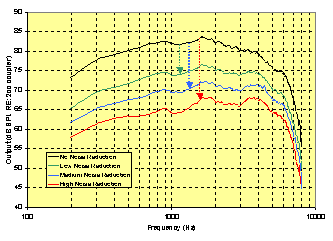
Clinical Investigation:
A recent clinically-based study evaluated speech comprehension in noise when combining SONIC innovations' core signal processing with Personalized Noise Reduction.7 Benefit is expressed as a change in performance between unaided and aided conditions, and between aided conditions with and without PNR. Spectral, temporal and spatial cues were eliminated or reduced during testing. First, the use of noise with the same long-term average spectrum as the sentences controlled for possible spectral mis-match. Next, the application of steady-state noise prevented temporal gaps, providing a test condition of 'speech detection in noise' rather than 'speech detection in noise gaps.' Last, the use of a single loud speaker for both target and masker located at 0? azimuth eliminated spatial and head shadow cues.
Subjects were tested aided and unaided with and without PNR using the Hearing in Noise Test (HINT).8 The HINT is a standardized test that determines a patient's reception threshold for sentences (RTS) in noise. The noise level is fixed at 65 dB(A) with the level of the sentences adjusted until the patient repeats the sentences correctly 50% of the time. The 50% correct level is expressed in dB S/N with a lower threshold associated with a better score. The performance-intensity function of the HINT materials has a slope of almost 10% for each dB change in RTS. Therefore, a 1 dB difference (improvement) between conditions corresponds to approximately a 10% improvement in intelligibility.
Fig. 5. Mean HINT scores for 27 subjects. Lower thresholds indicate better scores. 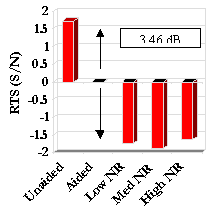
Results demonstrate a significant benefit with amplification and noise reduction (Figure 5). First, amplification significantly lowered RTS in the aided versus unaided conditions. Second, results show that any level of noise reduction significantly lowered thresholds in the aided noise reduction condition relative to the aided conditions without noise reduction. This means that the 3.3 to 3.6 dB difference between unaided and aided-with-PNR corresponds to approximately a 35% improvement in speech intelligibility in noise using SONIC innovations core signal processing and noise reduction algorithm.
Discussion:
The use of a single loudspeaker presentation to test the noise reduction algorithm in this experiment stands in stark contrast to the multiple loudspeaker arrays used to measure directional microphone performance. The single speaker design evaluates the 'worst case' scenario, where speech and noise originate from the same source. This is in contrast to the 'best case' scenario multi-speaker design, which places the noise source(s) at the side and/or behind the test subject, near the directional microphone null points. The first experimental design eliminates spatial and head shadow cues in order to maximally stress the system whereas the second design creates spatial and head shadow cues to enhance directional microphone benefit.
The steady-state noise used to test the noise reduction algorithm is the same HINT masker used in many directional microphone investigations. This masker matches the long-term-average spectrum (LTAS) of the male talker speaking the HINT sentences. Because the LTAS of the signal and masker are equally shaped, only short-term spectral mismatches are available to preferentially process the speech in noise. Presumably, it is these short-duration cues which allow normal hearing subjects to perform at about -3.7 dB S/N on this test. It should be noted that without hearing aids, the hearing impaired subjects in this study were about 5.5 dB S/N worse than normal performance, but with these advanced-technology hearing aids the subject group shifted to within 2 dB S/N of normal performance.
In a recent study of customer satisfaction using new hearing aids, five problematic listening environments were identified: large groups (37%), telephone (27%), concert/movie (20%), restaurant (18%), and car (13%), where the number in parentheses represents the proportion of consumers who were 'very dissatisfied' or 'dissatisfied.'9 In comparing the potential benefit of directional systems versus the noise reduction algorithm under evaluation, both systems provide benefit for the 'large group' and the 'restaurant' situations. In these listening environments, 'directional' hearing aids can take advantage of the spatial separation between the point source of the talker and the surrounding noise field, whereas the noise reduction aids can reduce the significant steady-state components of the conversational babble and environmental noise.
In evaluating the 'concert/movie' situation, the benefit from directionality may be minimal, especially if the environment is reverberant and the primary signal (be it music or speech) is coming from the same loudspeaker(s) as any competing or masking signals (which may be music, speech, or noise). For the 'telephone' and 'car' situations, directionality is not recommended, as the signal location is from the side, near the directionality null. In contrast, the noise reduction algorithm is insensitive to spatial separation and/or directionality, i.e. it is 'omni-directional noise reduction,' and can provide benefit for the 'concert/movie' environment, as well as for listening to speech on the 'telephone' (whether in M or T mode), or when driving a 'car' (whether passengers are in the side seat or the back seat).
Summary:
Contrary to conventional belief, patients with mild to moderate sensorineural hearing loss can achieve significant improvements in speech intelligibility in noise using a hearing instrument configured with a single omni-directional microphone and the signal processing described in this article.10 It is important to note that the improvements in speech intelligibility remained effective in conditions where directional hearing instruments cannot, by definition, show benefit - specifically when speech and noise originate from the same source.
References
- Ghent, Nilsson, Bray & Johnson (1999). 'Expansion as a sound processing tool in hearing aids.' Poster presentation at the 11th convention of the American Academy of Audiology.
- Ghent, Nilsson & Bray (2000). Uses of expansion to promote listening comfort with hearing aids.' Poster presentation at the 12th convention of the American Academy of Audiology.
- Bray & Ghent (2001). 'Expansion as a tool for adaptation for amplification.' Seminars in Hearing, in press.
- Nilsson, Fang & Bray (2000). 'Noise reduction in a 9-channel DSP hearing aid.' Poster presentation at the 12th convention of the American Academy of Audiology.
- Nilsson, Fang, Ghent, Murphy & Bray (2000). 'Improved speech intelligibility in noise with a single microphone noise reduction technique.' Poster presentation at the 140th meeting of the Acoustical Society of America.
- Nilsson, Bray, Ghent & Murphy (2001). 'Single microphone noise reduction: New findings.' Poster presentation at the 13th convention of the American Academy of Audiology.
- Nilsson, Soli & Sullivan (1994). 'Development of the hearing in noise test for the measurement of speech reception thresholds in quiet and in noise.' Journal of the Acoustical Society of America, 95(2), 1085-1099.
- Bray & Nilsson (2000). Objective test results support benefits of a DSP noise reduction system. The Hearing Review, 7(11), 60-65.
- Kochkin (2000). 'MarkeTrak V: Consumer satisfaction revisited.' The Hearing Journal, 53(1).
- Bray (2001). 'Directionality and/or Noise Reduction.' Presentation at the 13th convention of the American Academy of Audiology.
For more information on Sonic Innovations click here.
Click here to visit the Sonic Innovations website.

